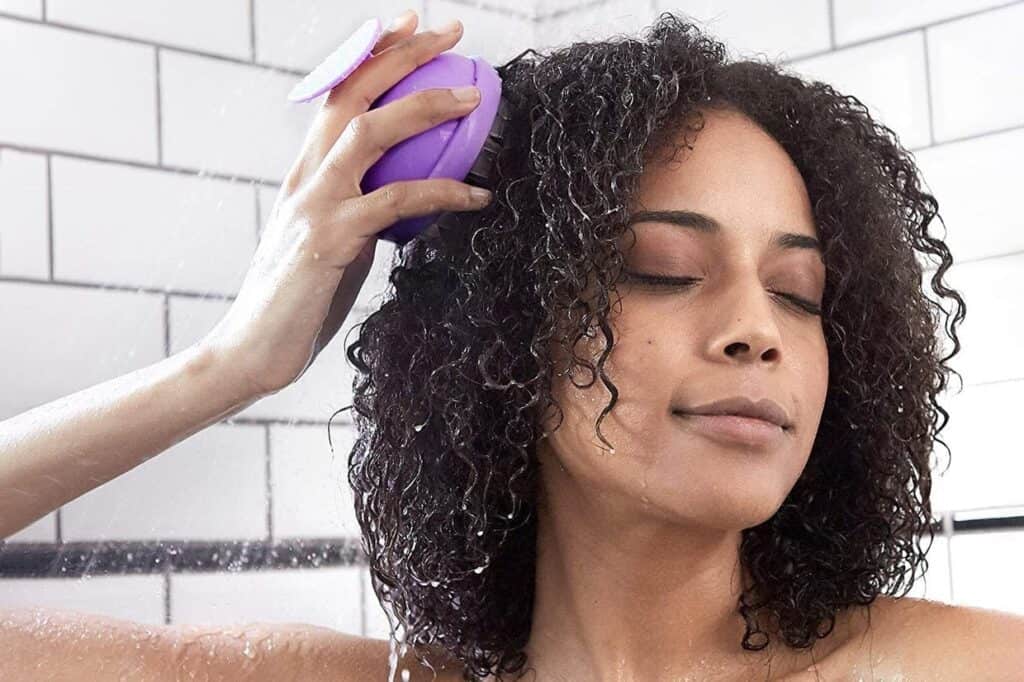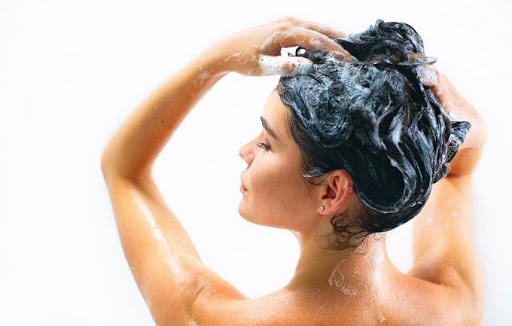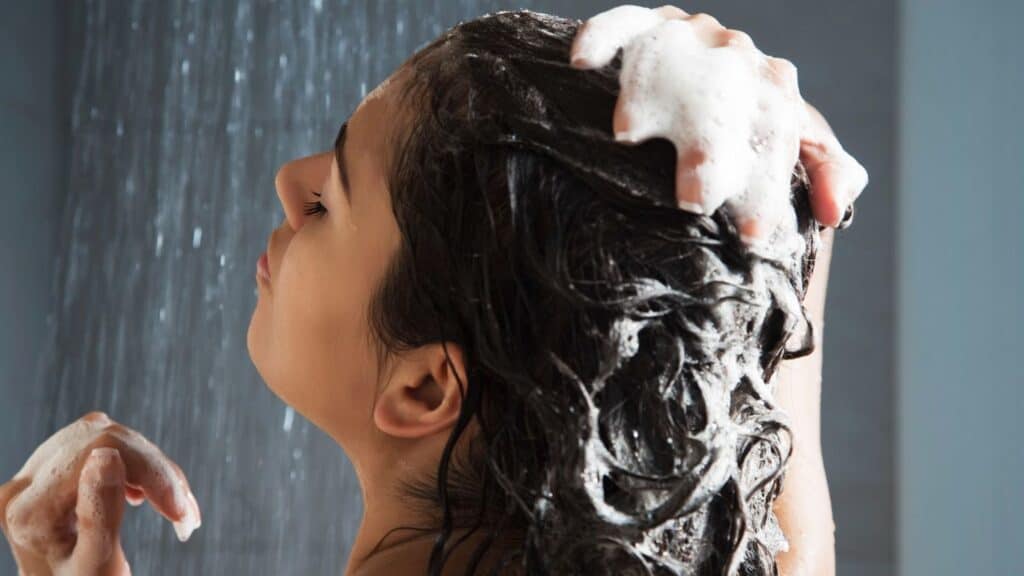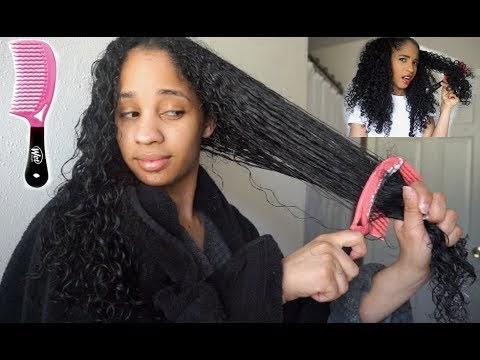It’s annoying when you wash your hair and it’s tangled; the shampoo messes up your hair as soon as you rub it. You are confused and don’t know how to handle it.
Read our article “Why does shampoo tangle my hair?” for a detailed explanation as well as helpful tips in this situation.
Why Does Shampoo Tangle My Hair?
1. Damaged hair from heating and chemical
Damaged hair from dyeing or bleaching is more prone to knots while shampooing than healthy hair. The cuticle of healthy hair is made up of small scales that sit flat against each other, resulting in a smooth and shiny look.
Damaged hair’s scales become ragged and rise up. The scales make them more likely to snag on other hairs, and water and shampoo cause the cuticle to open even more.
As a result, the wet hairs tangle easily with one another. And the more your cuticle is damaged, the more knots build in your hair.
2. The hair is not fully tangle-free before wetting
You may not be completely detangling your hair before getting it wet, which can cause already tangled hair to mat or knot even more. It is unavoidable for hair to become knotted in some way when being washed.
Untangling the hair, on the other hand, worsens the situation.

Detangling your hair fully before shampooing
3. Not wetting your hair thoroughly
Most people do not fully soak their hair before using shampoo, which makes it more knotted. The shampoo lathers better and distributes evenly on wet hair.
As a result, it will provide the greatest amount of moisture to each strand of hair while also decreasing friction when rubbed, resulting in straight, tangle-free hair.
4. Using very hot water
Overusing extremely hot water stresses your hair, resulting in frizzy, brittle, and dry tresses that are more prone to tangling.
Hot water also causes dandruff, itching, and weakens your hair roots, resulting in more damaged hair. As the strength of your hair is compromised, it becomes more sensitive to split ends, dryness, and tangles more easily.
5. Using a very harsh shampoo formula
When you use a strong shampoo recipe on your hair, it becomes more vulnerable to damage. Your hair becomes damaged and knotted more frequently as a result of harsh product and residue build-up.
Moreover, using the wrong shampoo might also cause your hair to tangle.
Check out:
- Are Drugstore Shampoos Bad For Your Hair?
- The 10 Best Drugstore Shampoos And Conditioners For Dry Damaged Hair
- The 8 Best Shampoos To Make Hair Soft And Silky
6. Applying shampoo the wrong way
It is not a good idea to apply shampoo directly to your hair, since this may cause your hair to tangle.
Your shampoo will sit in a blob on one area of your hair. It is necessary to spread it evenly through your strands to avoid knots when washing your hair.

Applying shampoo the right way will bring you a great finish.
See also:
- How Much Shampoo Do You Need?
- Can You Shampoo Without Conditioner?
- Is It Good To Mix Shampoo With Conditioner?
How to keep your hair from tangling when you wash it?
1. Brush before washing
Before you wash your hair, gently comb it with a wide-tooth comb or a soft-bristle brush. Start at the bottom and work your way up, rather than brushing from roots to ends, which can cause extra pressure to your strands. This will help stop knots from forming when you shampoo.
2. Using lukewarm water
Rinse your hair in lukewarm water. Lukewarm water helps open the hair’s cuticles, allowing the shampoo to enter deeper and eliminate debris and oil.
The open cuticles will be able to absorb the conditioner’s moisturizing easier, resulting in less knotted hair.
3. Focus shampoo on the scalp
Wet your hair completely with water and massage the shampoo into a lather. Massage the shampoo into your hair from roots to ends, concentrating on your scalp.
You’ll still have clean hair. And it’ll be less knotty because the majority of the oil and dirt will be on your scalp.
This method of washing can help you get rid of knots and leave you with beautiful, healthy hair.

Focus shampoo on the scalp.
4. Using conditioner
After rinsing off the shampoo, apply a generous amount of conditioner to your hair. Comb through your hair with a wide-tooth comb once your strands have been fully covered with conditioner, especially where your hair tends to get knotted.
Not only will combing your hair assist to remove any leftover knots, but it will also help to evenly distribute the conditioner.
Finish washing your hair with cool or cold water to close the cuticles, lock the moisture to keep your hair shiny and smooth. If your hair is often tangled after washing, use a leave-in conditioner after washing.
5. Choosing the right shampoo
The wrong shampoo might cause more knots to your hair than you know. Because shampoos have different cleaning capacities, it’s important to determine your scalp type before selecting one.
If you have oily roots, you may need a shampoo that is less hydrating and more cleaning. Switch to a super hydrating formula if your hair is naturally dry, coarse, medium to thick, and chemically treated.
How to Detangle Wet Hair while Shampooing?
You can use a shampoo brush to detangle your hair while shampooing. But if you don’t have, don’t untangle your hair immediately.
After rinsing off the shampoo, apply conditioner to your hair and keep it on for a few minutes. The conditioner will make your hair more slippery and easier to comb by reducing friction between hair strands.
Use a wide-tooth comb to distribute conditioner through your hair to saturate strands and detangle knots.
For hair that’s extra knotty, we suggest slathering on Pantene Gold Series leave-on Detangling Milk and allowing it to penetrate your strands for 3-5 minutes before going in with the comb and then rinsing.
Read more: How To Detangle Matted Hair Without Cutting?
Frequently Asked Questions
1. What shampoo is good for tangled hair?
You should choose a specialized, nourishing, mild shampoo containing no harsh chemicals for frizzy hair. They reduce friction between hair strands, which avoids tangling.
2. Should you detangle wet hair?
When your hair is wet, it becomes weaker, more delicate, and more prone to breakage. As a result, combing your hair when it’s wet might cause additional hair to fall out.
Allow your hair to air dry for at least 80 percent of the time before combing out tangles. Working from the ends of your hair up, use a wide-tooth comb.

Brushing wet hair can cause hair loss and breakage
3. Is it better to detangle with a comb or brush?
When it comes to detangling your hair, choosing the appropriate tool is more important than deciding between a comb and a brush.
A paddle brush, detangling brushes, or a wide-tooth comb are the ideal tools for detangling hair since they are gentler on the hair. Plastic brushes specifically designed for detangling wet hair are also available on the market.
4. How can you make your hair less frizzy?
Frizz is created by hair that is dry and lacking moisture. Humid, wet weather, on the other hand, tends to worsen frizzy hair.
If you want to achieve a smoother look to your locks, regularly trim the ends of the hair, softly absorb the hair with a soft towel after washing, or use a weekly hair mask.
Closing Points
Now you must have the answer to the question: “Why does my hair get tangled after shampooing?” Read the post to find out the cause, discover how to untangle hair and how to avoid it.
We hope you had a great time with this article and see you in the next one.
Sure! Please let me know if there is anything else I can do for you.